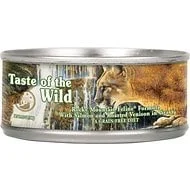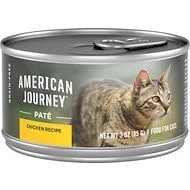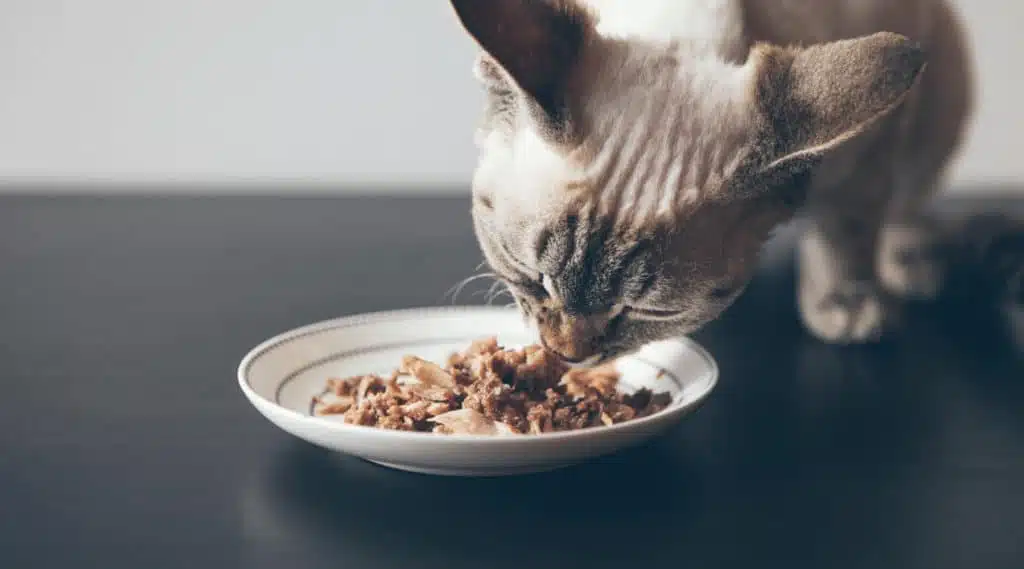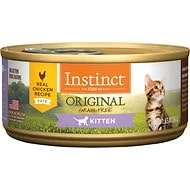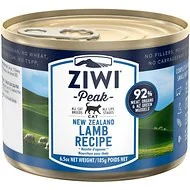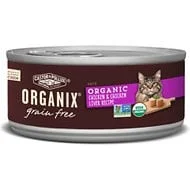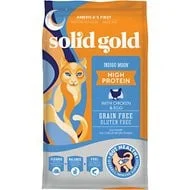10 Best High-Protein Cat Foods in 2025
Quick Guide
- What Is The Best High Protein Cat Food?
- The Importance of Protein in Cat Food
- How Much Protein Do Cats Need?
- Are There Any Special Considerations for High-Protein Cat Food?
- What Should You Look for in a Good Cat Food?
- How Do We Make Cat Food Recommendations?
- The 10 Best High-Protein Cat Foods
- 4 More Top-Rated High-Protein Cat Foods
- Castor & Pollux Organix Grain-Free Organic Chicken & Chicken Liver Canned Cat Food
- Solid Gold Indigo Moon with Chicken & Eggs Grain-Free High-Protein Dry Food
- Stella & Chewy’s Chick Chick Chicken Dinner Morsels Freeze-Dried Raw Food
- Canidae Grain-Free PURE Ocean with Tuna Indoor Formula Limited Ingredient Diet Dry Food
- Frequently Asked Questions
When you picture a wild lion or cheetah, what do you see? You probably imagine it chasing down an antelope or stalking a young gazelle. Wild cats are born carnivores and, though there may be thousands of years between them, modern cats are no different.
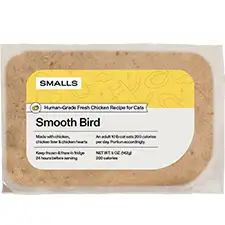
Smalls Human-Grade Ground Bird Fresh Cat Food
- Natural sources of taurine
- High in protein
Though you may not want to think about your cat chasing down and devouring live prey, that’s the kind of diet his body is still evolved to follow. This doesn’t mean you have to start feeding your cat mice, but you should seriously think about what you’re currently feeding him and ask yourself if it might be time for a change. At the very least, consider switching to a high protein cat food.
In this article, we’ll talk about the importance of protein in your cat’s diet along with special considerations to make before choosing a high protein cat food. You’ll also learn what you need to look for in a healthy cat food recipe and see our top picks for the best high protein cat food.
What Is The Best High Protein Cat Food?
The Importance of Protein in Cat Food
Your cat is descendant from wild ancestors that stalked the open plains. They lived a carnivorous diet consuming whole prey including the meat, organs, and bones of the animals. Modern cats typically subsist on a commercial diet, largely canned food or kibble, and most are a far cry from anything a wild cat would ever eat.
Cats are obligate carnivores which means their bodies are evolved to digest and utilize nutrients most efficiently from animal sources. Your cat’s body has unique anatomical characteristics that make it very difficult for him to digest plant foods – this is why protein is so important.
But what makes a carnivore a carnivore?
The idea that modern cats are carnivores is based on their ancestry, but it’s more than that. They have a short digestive tract which means they physically can’t digest plant products as well as proteins – protein, particularly raw prey, is highly digestible. There’s no need for a longer digestive tract filled with the fermenting bacteria that herbivores need to digest plant matter.
Additionally, cats obtain blood glucose (their primary source of energy) from the process of glucogenesis, using protein instead of carbohydrates as the main fuel source. If your cat doesn’t get enough protein in his diet, his body will actually start breaking down his own muscle and organs.
How Much Protein Do Cats Need?
When it comes to cat food, protein is absolutely essential, but how much protein do cats actually need?
If you consult the Association of American Feed Control Officials (AAFCO), you’ll see a recommended minimum of 30% crude protein for growth and reproduction (kittens and lactating females) and a minimum of 26% for adult maintenance.
The thing to keep in mind here is that these are the bare minimums needed to sustain a cat – there are no maximum requirements. Generally speaking, the more protein in your cat’s diet, the better. Choosing a cat food that meets AAFCO requirements doesn’t necessarily mean it contains the ideal concentration of protein, just that it contains an adequate level of essential amino acids and may be less likely to cause your cat to become malnourished. These minimums are also not enough to determine the overall quality of a product.
Though 26% protein may meet your cat’s minimum requirements for amino acids, many pet nutrition experts recommend something closer to 35% to 45%.
Just remember that this refers to the dry matter calculation for crude protein – you’ll need to do some quick math to decipher this from the guaranteed analysis. There are dry matter calculators online you can use to find out the amount of crude protein by weight once the water has been removed from the product. Most dry foods contain around 10% moisture and canned foods closer to 80%.
Are There Any Special Considerations for High-Protein Cat Food?
When it comes to shopping for high-protein cat food, you first need to think about whether you want to feed dry food or wet food. Most pet nutrition experts recommend a high-quality canned food because they tend to be lower in carbohydrates and higher in protein than dry food. This isn’t exclusively true, however, so you’ll still need to evaluate the food to determine the carbohydrate content.
The simplest way to calculate the estimated carbohydrate content of cat food is to add up the percentages for crude protein, fat, fiber, moisture, and ash then subtract from 100.
Ash is simply a calculation of the inorganic material left behind when the food is burned – it’s a way of determining the mineral content. For dry food, ash content should be no higher than 7.5% and for canned food, no higher than 3%. You can use these numbers as estimations if the ash content isn’t listed on the guaranteed analysis.
Calculating the carb content of the food helps you understand the rest of the information on the guaranteed analysis in context. You still want to check the dry matter protein calculation and read the ingredients list to determine the quality of the proteins.
Remember, animal protein is more digestible for cats than plant matter, so look for real animal sources of protein as the primary focus of your cat’s diet.
What Should You Look for in a Good Cat Food?
When shopping for cat food, high protein low carbohydrate is best. If you’re looking for high protein cat food, you should make sure that two of the first three ingredients are real animal sources of protein. The first ingredient should definitely be one, but many recipes contain a carbohydrate ingredient within the top three. Check the guaranteed analysis for the protein and moisture content, then calculate the dry matter protein – it should be somewhere between 35% and 45%, especially for growing kittens.
Aside from high protein content, are some general things to look for in a good cat food:
- No unnamed meats or meat meals. In cat food, protein content is essential, but you need to be sure it comes from named sources. Generic meats and meat meals like poultry or meat by-products should be avoided in favor of named ingredients like chicken or beef meal.
- Healthy animal-based fats. Fat provides a concentrated source of energy for your cat as well as essential fatty acids. Animal-based fats are a more biologically valuable source, so look for a recipe with an animal-based fat as the primary source.
- Digestible carbohydrates and low-starch veggies. Protein should be the foundation of your cat’s diet, but limited content of digestible carbohydrates can be beneficial as natural sources for key nutrients. Look for things like whole grains and low-starch veggies.
- No artificial colors, flavors, or preservatives. These ingredients have no place in your cat’s food and their use is generally an indication of a poor-quality product.
- Limited use of synthetic supplements. Some vitamin and mineral supplements are often necessary to ensure nutritional balance in commercial cat food but avoid anything with too many added amino acids. This usually indicates poor quality in the meat ingredients and free amino acids are less biologically valuable to cats than natural animal sources.
How Do We Make Cat Food Recommendations?
We’re not veterinary nutritionists, but we’ve done a great deal of research on the nutritional needs of cats and how different commercial diets do or don’t meet them. We understand that you want what’s best for your cat and we’re right here by your side! We would never recommend anything that we wouldn’t be happy feeding our own cats, so take that for what it’s worth.
Here are some general requirements for a cat food recipe to receive our stamp of approval:
- A source of high-quality animal protein as the first ingredient
- At least 30% crude protein for kittens and at least 26% for adults
- A minimum of 9% crude fat for kittens and adults
- A balance of omega-3 and omega-6 fatty acids, primarily from animal sources
- A rich blend of nutrients from natural sources and supplements, as needed
- Limited carbohydrate content from digestible sources (like whole grains and veggies)
- No low-quality fillers, by-products, or artificial additives (preservatives, dyes, or flavors)
We’ve done our best to assemble a variety of high-protein cat foods to help you make your choice. Remember that you need to do your own calculations to determine the dry matter protein content versus the percentage you see on the label. Remember as well that the percentage listed is also usually a minimum, though there’s no guarantee that the actual protein content is higher.
The 10 Best High-Protein Cat Foods
When shopping for high-protein cat food, you don’t necessarily need to look for the words “high protein” in the name or on the label. Generally speaking, canned food is higher in protein than dry food, especially for the higher quality brands. We’ve done our best to include a few dry food options, but most of our picks are canned foods for that reason.
| Our 2025 Picks: Best High Protein Cat Foods | |||
Small Ground Bird Human-Grade Fresh Cat Food
|
CHECK PRICE | ||
Taste of the Wild Rocky Mountain
|
CHECK PRICE | ||
American Journey Chicken
|
CHECK PRICE | ||
Instinct by Nature’s Variety Original
|
CHECK PRICE | ||
Merrick Purrfect Bistro Indoor Senior
|
CHECK PRICE | ||
Ziwi Peak Lamb Recipe Canned Cat Food
|
CHECK PRICE | ||
Castor & Pollux Organix Grain-Free
|
CHECK PRICE | ||
Solid Gold Indigo Moon with Chicken & Eggs
|
CHECK PRICE | ||
Stella & Chewy’s Chick Chick Chicken
|
CHECK PRICE | ||
Canidae Grain-Free PURE Ocean with Tuna
|
CHECK PRICE | ||
Smalls Fresh Food Delivery
Dry Matter Protein Content: 66% min.
Our Top Overall Pick: If you want to feed your cat the best of the best, fresh food is something to consider. Smalls is our favorite fresh pet food subscription service and they send pre-portioned packages of fresh food right to your door. Simply provide some basic information about your cat’s age, weight, and activity level to calculate his calorie needs. Choose from a chicken or fish recipe and know that your cat will be getting premium quality nutrition. Higher in moisture than dry food but not quite as high as the average canned food, Smalls’s chicken recipe is packed with protein. It is cooked in small batches at moderate temperatures as well, so it retains more of the nutritional integrity than most commercial foods.
Taste of the Wild Rocky Mountain Grain-Free Canned Food
Dry Matter Protein Content: 44% min.
Most Popular High-Protein Cat Food: Because there are so many cat foods out there, it can be tough to make a single choice. This Taste of the Wild Rocky Mountain canned food is a great option because it comes from a popular, trust-worthy brand and it is high in protein. Featuring fresh salmon as the main ingredient, this formula also contains chicken liver, fresh chicken, smoke salmon, roasted venison, and ocean fish. Roughly calculated, this recipe only contains less than 3% carbohydrate. It is grain-free and contains some fresh fruits and vegetables as natural sources of key nutrients, though it does contain a fair number of synthetic vitamin and minerals added for nutritional balance.
American Journey Pate Chicken Recipe Canned Cat Food
Dry Matter Protein Content: 45% min.
Most Affordable High-Protein Cat Food: When it comes to quality cat food, protein can be expensive. Fortunately, American Journey is an affordable brand overall and they offer some high protein options. This Pate chicken Recipe Grain-Free Canned Food features fresh chicken as the primary ingredient with chicken liver as a supplemental source of protein and essential amino acids. It contains a limited number of carbohydrate ingredients like cranberries and blueberries which, in and of themselves, are also natural sources for key nutrients. As a pate, this recipe contains more protein than their chicken in gravy recipe and it is extremely low in carbohydrate but high in moisture content.
Instinct by Nature’s Variety Original Kitten Recipe Canned Food
Dry Matter Protein Content: 54% min.
Best High-Protein Kitten Food: Your kitten has high requirements for protein and calories to sustain his healthy growth and development. This Original Kitten Recipe from Instinct by Nature’s Variety is protein-packed and highly digestible, plus it’s rich in moisture and contains a high concentration of calories. This recipe features fresh chicken as the primary ingredient followed by beef liver, chicken broth, and salmon. It contains no added carbohydrates in any significant amount with the necessary vitamin and mineral supplements to ensure complete and balanced nutrition. Overall, it’s a great choice if you want to give your kitten the best start to life you possibly can.
Merrick Purrfect Bistro Indoor Senior Pate Canned Food
Dry Matter Protein Content: 42%
Best High-Protein Senior Cat Food: As your cat gets older, he may not need as many calories, but protein is still extremely important. In fact, it may be even more important because some older cats tend not to eat as much, so their bodies may start metabolizing their own muscle for energy. Our top pick in high protein cat food for older cats is Merrick Purrfect bistro Indoor Senior Pate Canned Food. This recipe is well within the recommended protein range for adult cats and much higher than AAFCO minimums, plus it is a moisture-rich and highly digestible canned food which is often easier for senior cats to eat. It features fresh chicken as the main ingredient with chicken broth and chicken liver as the next two.
Ziwi Peak Lamb Recipe Canned Cat Food
Dry Matter Protein Content: 43% min.
Best High-Protein Cat Food for Sensitive Stomach:If your cat has a sensitive stomach, you may want to consider a recipe made with a limited number of ingredients including a single source of animal protein. This Ziwi Peak Lamb Recipe Canned recipe is a great cat food. High protein low carbohydrate are two of the primary benefits, but overall it is highly digestible and made with a very limited list of ingredients. Fresh lamb is the first ingredient, supplemented with lamb organs to provide supplemental protein, amino acids, and other essential nutrients. There is only one carbohydrate ingredient and this formula is full of moisture and flavor.
4 More Top-Rated High-Protein Cat Foods
Castor & Pollux Organix Grain-Free Organic Chicken & Chicken Liver Canned Cat Food
Dry Matter Protein Content: 41% min.
When it comes to high protein cat food canned is usually best and this Castor & Pollux Organix Grain-Free Organic Chicken & Chicken Liver recipe is another great choice. Featuring organic ingredients like fresh chicken and chicken liver, this formula offers excellent nutritional quality. It is grain-free and contains an assortment of organic fruits and vegetables for added nutrition. This recipe is formulated for all life stages as well, so you could feed it to your kitten and not have to worry about switching to a different recipe as an adult.
Solid Gold Indigo Moon with Chicken & Eggs Grain-Free High-Protein Dry Food
Dry Matter Protein Content: 46% min.
If you prefer to feed your cat dry food, this high-protein recipe from Solid Gold could be a good choice. It features chicken meal as the primary ingredient which has already been dehydrated, making it a more concentrated source of protein. The recipe also contains fresh chicken, dried eggs, and ocean fish meal as supplemental protein sources. Peas may provide some plant-based protein, but it is the fourth ingredient and followed by three animal-based proteins. In addition to plenty of protein, this recipe is supplemented with fresh fruits and veggies as well as probiotics for healthy digestion.
Stella & Chewy’s Chick Chick Chicken Dinner Morsels Freeze-Dried Raw Food
Dry Matter Protein Content: 47% min.
Raw cat food is a highly nutritious option for cats, but it isn’t the most convenient. This Stella & Chewy’s Chick Chick Chicken Dinner Morsels Freeze-Dried Raw Food is a good alternative because it offers much of the same nutrition as raw food but the convenience of dry food. This recipe starts with chicken as the main ingredient, inclusive of the raw bone. It also contains chicken liver and chicken gizzard as the next two ingredients. There are no added carbohydrates except some carb content from the pumpkin seeds which act primarily as a source of fat. If you choose this recipe for your cat, it is best to rehydrate it with water or broth before feeding.
Canidae Grain-Free PURE Ocean with Tuna Indoor Formula Limited Ingredient Diet Dry Food
Dry Matter Protein Content: 39.5% min.
Indoor cats have unique nutritional recommendations because they are generally less active than outdoor cats and more prone to hairballs. This Canidae Grain-Free PURE Ocean with Tuna Indoor Formula is a good option in high protein dry food because it is formulated for indoor cats. It contains fresh tuna as the main ingredient, followed by salmon meal and menhaden fish meal. It does contain some carbohydrates, but the dry matter protein content is still within the recommended range. What makes this option a good choice is that it contains a very limited list of ingredients and doesn’t contain common proteins like chicken and beef. It may be an option for cats with food allergies.
Frequently Asked Questions
- What are the benefits of high-protein cat food? Your cat has high biological requirements for protein in his diet with minimum requirements for essential amino acids. Animal proteins are complete proteins which means that each one contains all of the essential amino acids – this is not always true for plant proteins. High-protein cat food helps your cat build and maintain healthy muscle. It also provides a usable source of energy. When your cat eats a high-protein diet, he will be healthier and more energetic.
- What are the best protein sources for cats? Cats are descended from wild cats that roamed the plains. They subsisted on wild game meats, less so on fish and seafood. The most common protein sources in commercial cat foods are meat and poultry like beef, pork, chicken, and turkey. You’ll also find more exotic options like venison, lamb, and rabbit as well as a variety of different kinds of fish. Poultry and meat proteins are closer to your cat’s evolutionary diet, though fish can be a good option if your cat has allergies to common proteins.
- Can I feed my cat vegan or vegetarian cat food? Though it may be surprising based on what you’ve learned here, vegan and vegetarian cat foods do exist. Manufacturers claim that their products meet the minimum requirements for essential amino acids in cats, but the thing to remember is that they come from plant sources. Certain grains and legumes like corn and peas contain essential amino acids, but they are not complete proteins like animal products – they don’t contain ALL of the essentials. Some vegan and vegetarian cat foods rely on added amino acids to meet required minimums. Keep in mind as well that, for humans, vegan and vegetarian diets are a preference. There is no need to enforce your own dietary preferences onto your cat or dog when it is much healthier to feed them the kind of diet their bodies were adapted to follow.
- How much should I feed my cat? The amount you feed your cat depends on his age, weight, and activity level. Growing kittens require more frequent feeding to sustain their growth, though adult cats still need plenty of protein to maintain healthy body weight and energy. Most cats do well with two meals per day, though young and highly active cats may benefit from a third meal. Refer to the feeding recommendations on your cat’s food to ensure that he gets the right number of calories but remember that this is just an estimate. You’ll need to monitor your cat’s body condition and adjust his feeding as needed.
- Do growing kittens need more food and protein? Yes, growing kittens require more protein and calories than adult cats. Though AAFCO minimums for crude protein in kittens are 30%, this is certainly not ideal. Kittens do better with 35% to 45% protein in their diet, ideally from high-quality animal sources. Many kitten foods contain higher concentrations of fat to provide additional calories, but make sure the two are in balance.
If you want what’s best for your cat, you should feed him the highest quality cat food you can consistently afford. In most cases, the best option is a premium canned food made with high-quality animal proteins with a low concentration of carbohydrates. Premium kibble is fine as well, though it tends to be higher in carbohydrates and lower in moisture.
If you prefer the convenience of dry food, you can use it as your cat’s staple diet but be sure to add some high-quality canned food for a boost of moisture and protein. Either way, consider our recommendations above when it comes to choosing your cat’s diet!


